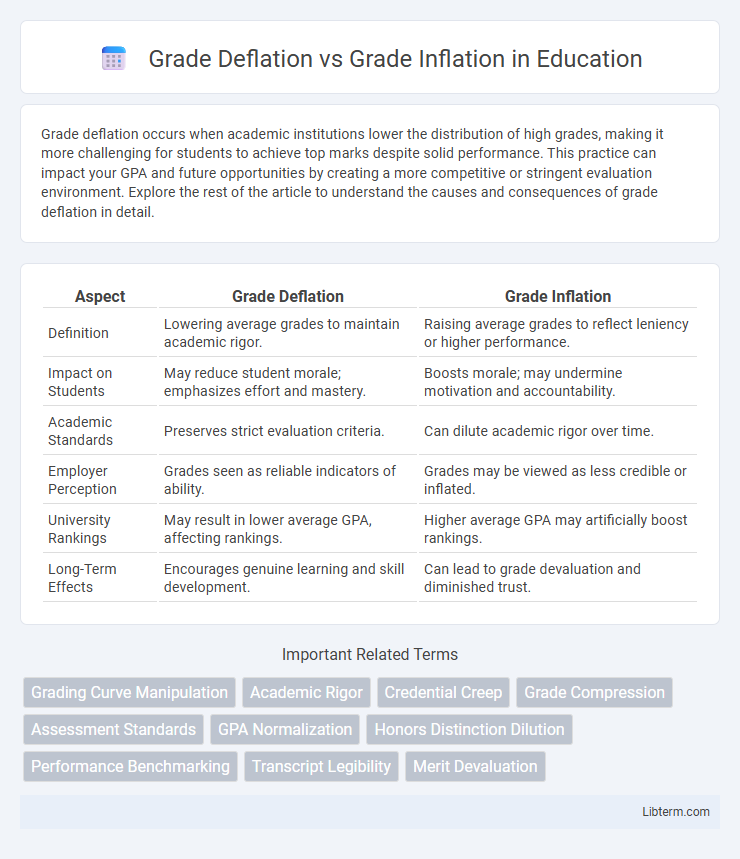Grade deflation occurs when academic institutions lower the distribution of high grades, making it more challenging for students to achieve top marks despite solid performance. This practice can impact your GPA and future opportunities by creating a more competitive or stringent evaluation environment. Explore the rest of the article to understand the causes and consequences of grade deflation in detail.
Table of Comparison
| Aspect | Grade Deflation | Grade Inflation |
|---|---|---|
| Definition | Lowering average grades to maintain academic rigor. | Raising average grades to reflect leniency or higher performance. |
| Impact on Students | May reduce student morale; emphasizes effort and mastery. | Boosts morale; may undermine motivation and accountability. |
| Academic Standards | Preserves strict evaluation criteria. | Can dilute academic rigor over time. |
| Employer Perception | Grades seen as reliable indicators of ability. | Grades may be viewed as less credible or inflated. |
| University Rankings | May result in lower average GPA, affecting rankings. | Higher average GPA may artificially boost rankings. |
| Long-Term Effects | Encourages genuine learning and skill development. | Can lead to grade devaluation and diminished trust. |
Understanding Grade Inflation and Deflation
Grade inflation occurs when higher academic grades are awarded for work that would have received lower grades in the past, diminishing the value of high marks and complicating student assessment. Grade deflation, in contrast, involves assigning lower grades than deserved, often to maintain rigorous academic standards but potentially demoralizing students. Understanding these phenomena requires analyzing institutional grading policies, trends in GPA distributions, and their impact on student motivation and academic credibility.
Historical Context of Grading Trends
Grade deflation and grade inflation have evolved significantly since the early 20th century when grading systems became standardized across educational institutions in the United States. Historical data reveals that grade inflation accelerated notably from the 1960s onwards, coinciding with broader social changes and increased competition for college admissions. In contrast, some selective universities implemented grade deflation policies in the 1980s and 1990s to preserve academic rigor and distinguish exceptional student performance.
Causes of Grade Inflation
Grade inflation primarily results from increased pressure on educators to award higher grades to meet student satisfaction and retention goals, often driven by institutional ranking concerns. The widespread use of subjective grading criteria and the desire to avoid student conflicts also contribute to the gradual rise in average grades. Furthermore, grade inflation is exacerbated by the expansion of grade-driven scholarship opportunities that incentivize students and institutions to maintain elevated academic performance levels.
Drivers Behind Grade Deflation
Grade deflation is primarily driven by institutions aiming to maintain rigorous academic standards and preserve the value of their degrees. Factors such as stricter grading policies, increased competition among students, and efforts to counteract previous grade inflation contribute significantly to this trend. University administrations often implement grade deflation to enhance a school's reputation for academic excellence and ensure that grades accurately reflect student performance.
Impact on Student Motivation and Performance
Grade deflation can lower student motivation by fostering a competitive environment where higher effort may not equate to significantly better grades, potentially discouraging risk-taking and innovation. Conversely, grade inflation may boost short-term student morale but can diminish long-term performance by reducing the incentive to achieve mastery and maintain rigorous academic standards. Both phenomena influence student outcomes, with deflation emphasizing precision and inflation risking grade dilution, affecting overall academic growth and motivation dynamics.
Consequences for College Admissions
Grade inflation distorts academic achievement signals, causing admissions committees to struggle differentiating truly exceptional students from average performers, while grade deflation may unfairly penalize high-achieving applicants by lowering their GPA relative to peers. Colleges relying heavily on GPA risk admitting less qualified candidates under inflation or overlooking strong contenders impacted by deflation, potentially skewing campus diversity and overall academic standards. Standardized test scores and holistic review processes attempt to offset these distortions, but inconsistencies in grading practices continue to complicate equitable college admissions decisions.
Effects on Job Market and Employer Perceptions
Grade deflation often leads employers to question whether candidates' GPAs accurately reflect their abilities, potentially prompting a deeper evaluation of skills beyond academic records. Grade inflation can dilute the meaning of high grades, making it challenging for employers to differentiate top performers, often necessitating reliance on internships or extracurricular achievements. Both phenomena impact recruitment strategies and highlight the importance of holistic candidate assessment in the competitive job market.
Academic Integrity and Fairness
Grade deflation challenges academic integrity by encouraging stricter evaluation standards that prevent grade inflation, ensuring that grades accurately reflect student performance and merit. Conversely, grade inflation risks undermining fairness by diluting academic standards, making it difficult to distinguish true excellence and potentially devaluing genuine achievement. Maintaining a balanced grading system is essential to uphold fairness and preserve the credibility of academic assessments.
International Comparisons in Grading Standards
International comparisons in grading standards reveal significant disparities between countries experiencing grade deflation and those facing grade inflation. For instance, South Korean universities often implement strict grading curves leading to grade deflation, while U.S. institutions, particularly in liberal arts colleges, report widespread grade inflation with average GPAs rising above 3.0. These contrasting trends impact global academic competitiveness, student motivation, and the interpretation of academic credentials in international job markets.
Solutions and Policy Recommendations
Implementing standardized grading rubrics and continuous faculty training can effectively address grade inflation and deflation by ensuring consistency and transparency in evaluation criteria. Encouraging the use of multiple assessment methods, such as portfolios and project-based evaluations, reduces reliance on traditional exams that often skew grading distributions. Institutions should also establish clear grade distribution policies to promote fairness and maintain academic standards while providing regular data analysis to monitor grading trends over time.
Grade Deflation Infographic

 libterm.com
libterm.com